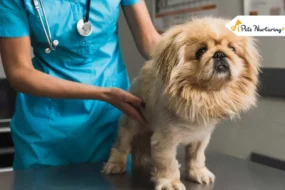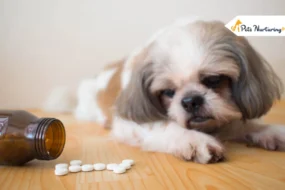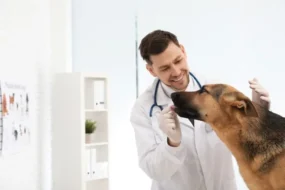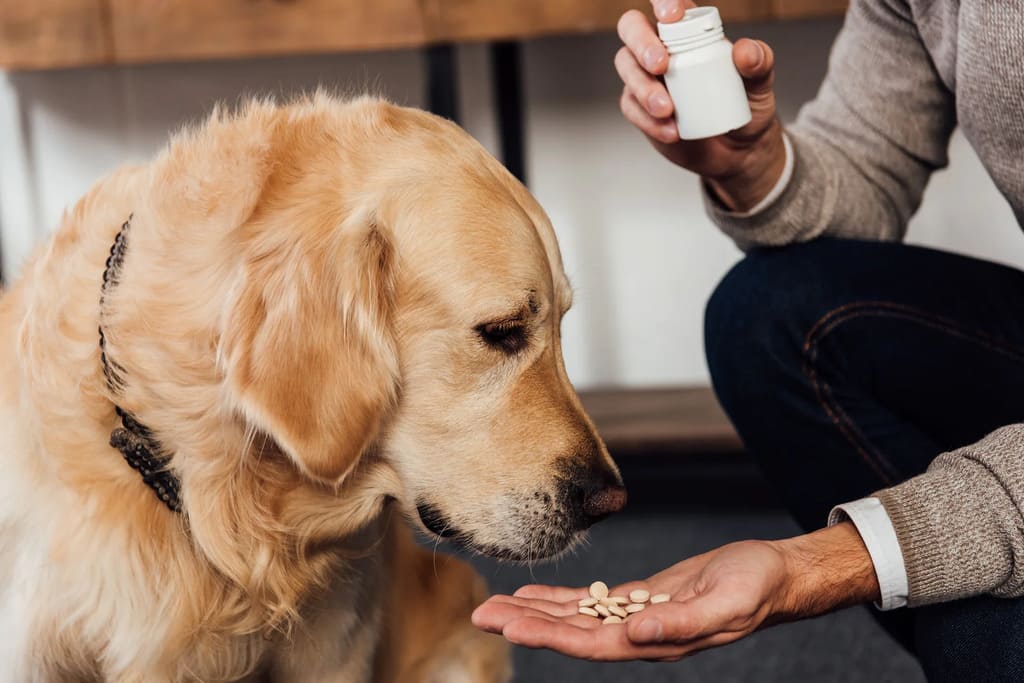
Dogs are curious and active beings who always find ways to get in trouble! From chewing your favorite shoe to destroying your flower garden, your pup can be in any difficult situation. Most of the time, these things can be handled easily, but sometimes they end up in seriously problematic things like eating a poisonous plant or getting stung by a bee. Due to this, your canine may suffer from itchiness, swelling, or other allergic reactions.
You can use Diphenhydramine (Benadryl) to make your pup more comfortable. This medicine is used to ease severe allergic symptoms and reactions. However, the guidance of the vet is EXTREMELY IMPORTANT!
Can dogs have Benadryl?
Yes, dogs can have Benadryl. However, it’s crucial to know that Diphenhydramine reacts differently for humans and animals, especially dogs. This is why knowing when and how much Benadryl should give to dogs and their reactions is vital.
This blog explains every information you need to know about Benadryl for dogs. From its dosage and side effects to its benefits and when to consult a vet, we’ve covered all the important topics. So, if you have questions like, can dogs take Benadryl or how much Benadryl to give a dog, keep reading till the end.
Let’s begin.
What Is Benadryl?
Diphenhydramine, also known as Benadryl, is a first-generation antihistamine that relieves the symptoms of allergies. The body produces histamines to get rid of an allergen; however, this can also lead to sneezing, itching, etc. Benadryl blocks the H-1 receptors in the body from reacting to histamine, which reduces allergy symptoms. This is why it’s widely used for both humans and dogs.
Vets use Diphenhydramine to treat allergy reactions and insect bites/stings in dogs. However, the correct dosage is extremely important. Why? Because Diphenhydramine reacts differently in dogs and in humans.
What Does Benadryl Treat in Dogs?
Most of the time, the vet uses Diphenhydramine for dogs with mild-to-moderate allergies. This is a great medication for canines for allergies like food allergies, seasonal allergies, and environmental allergies.
Benadryl is great for skin allergies, snake and insect bites, and allergic reactions such as nausea and itchiness in dogs. It is also highly beneficial for reducing other allergy symptoms, including:
- Hives
- Sneezing
- Itchiness
- Red and inflamed skin
- Swelling and inflammation
- Red, itchy eyes
- Coughing or hacking
- Runny nose and eyes
- Itchy or red ears
Can I Give My Dog Benadryl?
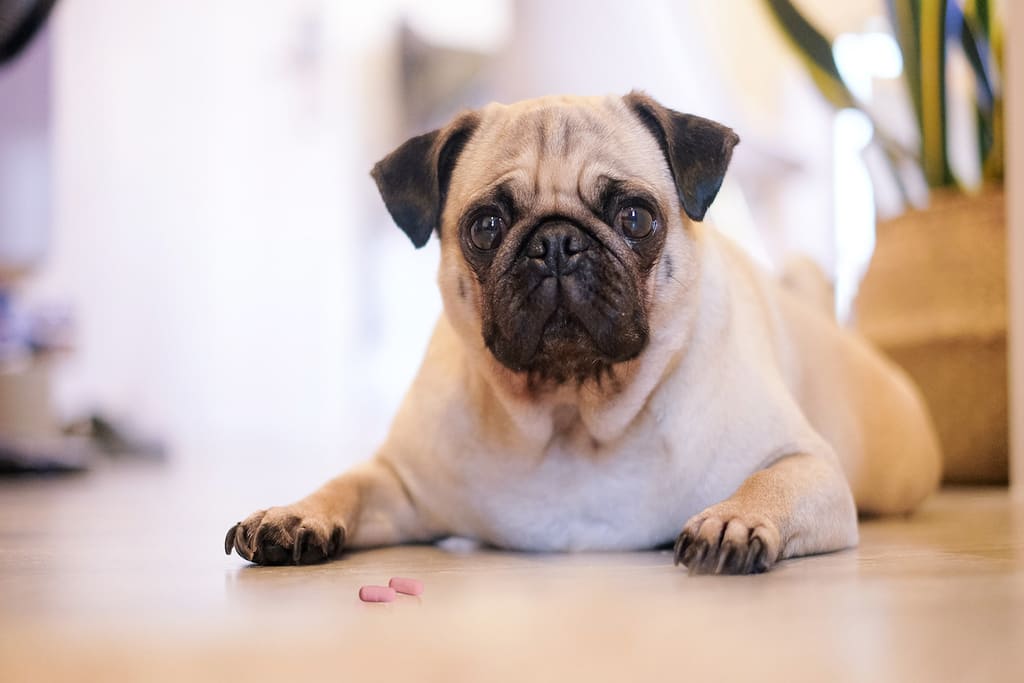
The answer is both YES and NO!
You should always ask your vet first!
Let’s think this way – we all can eat foods like chocolates and grapes, but these regular food items can be extremely harmful for dogs. The same thing goes for medicines. Benadryl is meant for human consumption and can also treat dog’s allergies; however, the wrong dosage can severely affect your pup.
Is Benadryl Safe for Dogs?
Benadryl is useful for dogs in situations like:
- Anxiety: Diphenhydramine is widely used to treat symptoms of allergies, such as rashes, itching, and anxiety.
- Motion sickness: This medicine has sedating effects, which help to fight motion sickness in dogs during traveling like car and airplane rides.
- Vaccine reactions: After vaccinations, pups can have several reactions like swelling or fatigue. This is when the vet often recommends Benadryl for dogs.
- Insomnia: For canines who have trouble sleeping, Diphenhydramine can help your puppy feel drowsy, and later he will sleep.
NOTE:
While giving Diphenhydramine to dogs, make sure your puppy isn’t on any other medication. It can react with other medicines and result in serious health conditions. This is why asking your veterinarian about Benadryl for dogs is imperative.
Types of Benadryl For Dogs
Can you give dogs Benadryl in any form?
Benadryl is available in different forms, but some are not good for dogs. Let’s know which form of Benadryl you should give to your pup.
- Liquid Benadryl: It contains alcohol, so it is highly toxic for dogs.
- Benadryl Tablets: You can give tablets to your dog, but you need to hide them in their favorite food or treat. But never use the time-release tablets for canines.
- Children’s liquid formula: This form of Benadryl contains no alcohol and is less concentrated, so you can give it to small dogs.
- Benadryl Spray: This can be used in emergencies, like when a dog is bitten by a snake or bee/insect where he can’t breathe. But spraying directly on the wounds may discomfort your pup.
- Benadryl Creams: You can use creams or gels on your dog’s itchy skin or rashes.
- Injections: The vet uses a Benadryl injection for severe allergic reactions.
Benadryl Dosage for Dogs
How much Benadryl for a dog?
Each medication has its reaction and dosage limits. The dosage is extremely important as sometimes different formulations are combined with other medications such as Tylenol. This is why it’s critical to check if the tablets only contain Diphenhydramine.
You can give Benadryl to dogs, but the real question is how much?
The amount of Benadryl for dogs usually depends on the size and weight of your pup. This is because every dog breed is different, and they can react differently.
According to the vet, the most recommended dosage for dogs is 2–4 milligrams per kilogram (Kg) of body weight, or 0.9–1.8 milligrams (mg) of Benadryl per pound.
- Benadryl Dosage for Small Dogs
Dogs that weigh less than 25 pounds fall into the small dog breed category. You can use a children’s formula of liquid Benadryl at a 0.4 mL/lb dosage.
- Benadryl Dosage for Medium-to-Large Dogs
You can give 1 Benadryl tablet (1 mg) every 8-12 hours to medium to large dogs (over 25 pounds).
How much Benadryl can I give my dog?
Here is a complete Benadryl dosage chart for dogs:
| Benadryl for Dogs Dosage Chart | ||
| Max Dose (every 8-12 hours) | Max Dose (every 8-12 hours) | |
| Dog Weight | Tablet (mg) | Children’s Liquid (ml) |
| 1 lbs – 10 lbs | 1 mg – 10 mg | 0.4 ml – 4 ml |
| 10 lbs – 20 lbs | 10 mg – 20 mg | 4 ml – 8 ml |
| 20 lbs – 30 lbs | 20 mg – 30 mg | 8 ml – 12 ml |
| 30 lbs – 40 lbs | 30 mg – 40 mg | 12 ml – 16 ml |
| 40 lbs – 50 lbs | 40 mg – 50 mg | 16 ml – 20 ml |
| 50 lbs – 60 lbs | 50 mg – 60 mg | 20 ml – 24 ml |
| 60 lbs – 70 lbs | 60 mg – 70 mg | 24 ml – 28 ml |
| 70 lbs – 80 lbs | 70 mg – 80 mg | 28 ml – 32 ml |
| 80 lbs – 90 lbs | 80 mg – 90 mg | 32 ml – 36 ml |
| 90 lb – 100 lbs | 90 mg – 100 mg | 32 ml – 36 ml |
| 100 lbs – 110 lbs | 100 mg – 110 mg | 40 ml – 44 ml |
| 110 lbs – 120 lbs | 110 mg – 120 mg | 44 ml – 48 ml |
| 120 lbs – 130 lbs | 120 mg – 130 mg | 48 ml – 52 ml |
| 130 lbs – 140 lbs | 130 mg – 140 mg | 52 ml – 56 ml |
| 140 lbs – 150 lbs | 140 mg – 150 mg | 56 ml – 60 ml |
How Long Does It Take Benadryl to Work in Dogs?

Generally, Benadryl or Diphenhydramine takes almost 24 hours to kick in for dogs.
However, for canines with liver or kidney or heart diseases, the effect of Benadryl can last longer. So, if your pup has similar health issues, ask your vet about the dosage and effects of Benadryl.
When NOT to Give Benadryl To Dogs?
Benadryl or Diphenhydramine should never give (or should be given with precaution) to canines suffering from the following medical issues:
- Cardiac conditions (cardiovascular disease or heart failure)
- Liver disease
- Asthma
- Prostatic hypertrophy
- Difficulties in urinating
- Bladder neck obstruction
- Glaucoma
- Allergic lung conditions
- Pregnancy or nursing
- Hypertension
- High blood pressure
- Seizure disorders
- Hyperthyroidism
- Low blood pressure
Side Effects of Benadryl on Dogs
Are there any severe side effects of Diphenhydramine?
Benadryl side effects in dogs are similar to those in humans. Common side effects include dry mouth, sleepiness, and urine retention.
Yes, just like any other medication, Benadryl also has side effects. Here are some common side effects of Benadryl:
- Dry mouth
- Sleepiness
- Lethargy
- Drooling
- Drowsiness
- Urine retention
- Vomiting
- Diarrhea
- Lack of appetite
Benadryl Overdose
Can an overdose of Benadryl killed my dog?
An overdose of Benadryl or Diphenhydramine can cause serious medical problems, such as
- Increased heart rate
- Rapid breathing
- Dilated pupils
- Agitation
- Seizures
- Constipation
When to Contact Your Vet?
If you’re thinking about when to ask about Benadryl for dogs, you should always consult the vet before you give Benadryl to your pup. Just by looking at allergy symptoms like itching and redness of the eyes, you think that Benadryl is good. It’s not.
These symptoms can also be signs of other medical conditions, and giving Diphenhydramine can further worsen the situation. Asking before giving it to your pup can save your pup’s life.
Also, if your dog has symptoms like increased heart rate, agitation, or seizures, you should immediately contact your nearest vet.
Natural Alternatives to Benadryl
If you’re concerned with the serious side effects of Benadryl, you can go with natural alternatives. Here is the list of natural alternatives to Benadryl available in the market:
- For Allergies/Antihistamines:
If your dog has allergic reactions such as sneezing and itching or cold-like symptoms, you can go with natural antihistamines like Stinging Nettle and Quercetin. Also, give your pup foods like eggs, fresh meats, fish, and non-citrus fruits.
- For Motion Sickness:
You can use natural herbs like peppermint, ginger, fennel, and catnip for motion sickness. These compounds produce an anti-nausea effect that will help your beloved pup in motion sickness while traveling.
- Anxiety:
Use natural solutions such as essential oils and massage if your puppy feels anxious. Exercise, music, and grooming are highly effective in relieving a dog’s stress and anxiety.
Conclusion:-
Benadryl or Diphenhydramine is a helpful medicine to cure anxiety, allergic reactions, motion sickness and several other conditions in dogs. However, it can also have side effects like dry mouth, seizures and rapid breathing. This is why it’s recommended to consult a vet before giving this medicine to your beloved pet.
So, this is all about Benadryl for dogs. To know more about pet-related information such as healthcare, food habits, medications, and grooming tips, explore PetsNurturing.
Explore Further:-








